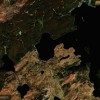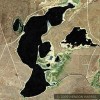
The Wei Chu-Hsien White Rhino Head
Posted on Friday, April 23rd, 2010
Location: Lewis & Clark┬Ā National Forest/Montana
I am dedicating the Montana White Rhino Head to Professor Wei Chu-Hsien for his book ŌĆ£China & America-Volume OneŌĆØ.
Studying in the 1920s at Tsing-Hwa University in Beijing Wei became convinced of the transpacific explorations of ancient Chinese to North America.
ŌĆ£ŌĆ”. stated that he, first coming across in 1916 a Confucius passage on 6 birds which flew backward as recorded in Spring and Autumn Annals, had linked the ŌĆśyiŌĆÖ (alien) bird to AmericaŌĆÖs hummingbirds.ŌĆØ
There are no hummingbirds indigenous to China. All hummingbird species are native to North, Central & South America. To my knowledge no other bird flies backward.┬Ā How then did the Chinese of Confucius time and before know of this bird?
He ŌĆ£felt that his theory had been vindicated by the discovery of stone anchors near (the) California coast in Nov 1982ŌĆØ
ŌĆ£Ancient Chinese had different terms for barbarians in four directions. Dongyi or Yi-of-the-East will include peoples in Manchuria, Korea and Japan. In early times, the Yi was associated with the word ‘niao’ for bird, and there were eight to nine different ‘niao-yi’ people in the east. Shang Dynasty people, considered a group of Yi people, were recorded to have treated ‘Xuan Niao’ (i.e., Black bird, possibly sparrow) as their totem. Manchurian legends as to the birth of their founder had something to do with birth-mother swallowing the red fruit dropped by a bird. Toba Wei Dynasty, in return for being called the nickname of ‘suo lu’ (pigtailed enemies), would call southern Chinese by the derogatory name of ‘niao yi’ (i.e., bird aliens) for possibly southern Chinese pitched accents or generic kind of name for southeastern Chinese and islanders. In later times, the Yi designation would be associated with a word ‘dao’ for island, pointing to the barbarian peoples in East China Seas. (Both the character ‘niao’ and ‘dao’ looked quite close and might have corrupted consecutively during the course of history.) Yi is more an inclusive word to mean aliens. The big Korean school of thought, touched on in prehistory section, claimed that the Koreans were true descendants of the Dongyi people.ŌĆØ
ŌĆ£Prof Wei had cititations of dozens of entries about the Redwood Tree, which was known to Chinese as the ŌĆśFu-sangŌĆÖ in Chinese texts prior to BC eras. Apparently, ancient Chinese in AD eras, i.e., Monk Hui-Shen of the 5th century, had mutated the ancient term ŌĆśFu-sangŌĆÖ to mean something different from the Redwood tree.ŌĆØ
Throughout ancient Chinese myths, legends and literature there are references to a wonderful place where large trees grow to enormous heights. One of the most famous places where this is mentioned is in the legend of the 10 Sun/Ravens. In the legend the ten suns one at a time would begin their journey each morning across the Eastern Sea to China from their home in a castle atop a huge Fu-sang (Redwood) tree. The sun would return home and take his turn to begin his individual journey ten days hence as there were 9 other suns making the same rotation in turn. The huge tree became so famous that they named the whole continent Fu-sang. The Redwoods were beautiful and awe inspiring then. They still are today. (ThatŌĆÖs why in June IŌĆÖm going up to Northern California to stand at the base of the trees in amazement again just as the ancients did.)
ŌĆ£Prof Wei Juxian validated ancient Chinese texts [prior to BC eras] as to the abundance of silver and gold in ancient America that the American natives did not treasure the metals as recorded in “Liang Shu”
Rhinos are indigenous to Africa and India. The Rhino from India has one horn and the African Rhino has two. However, the question is: If this stand alone large scrapped white colored clearing in Montana is in fact the image of a head of a white Rhino then which civilization/s on earth at that time would have known of this animal?
Wei Chu-Hsien White Rhino Head In A Leaf-Like Frame
The Beak of the 10th Sun Raven STILL GLOWS!



















Chinese Discover America » Blog Archive » Possible Dating of These North American Geoglyphs says: July 14th, 2010 at 5:50 am
[…] key to my newfound belief is The Wei Chu-Hsien White Rhino Head that I posted on April 23, 2010. At the time of my posting I was puzzled as to why Chinese artists […]
Chinese Discover America » Blog Archive » Ancient Geoglyphs/ Totems of Pangu in the Americas says: July 31st, 2010 at 4:25 am
[…] Head The Wei Chu-Hsien White Rhino Head Run Overlay Page […]